Copyright 2012 National Geographic Society
All rights reserved. Reproduction of the whole or any part of the contents without written permission from the publisher is prohibited.
Published by the National Geographic Society
John M. Fahey, Jr., Chairman of the Board and Chief Executive Officer
Timothy T. Kelly, President
Declan Moore, Executive Vice President; President, Publishing and Digital Media
Melina Gerosa Bellows, Executive Vice President; Chief Creative Officer, Books, Kids, and Family
Prepared by the Book Division
Hector Sierra, Senior Vice President and General Manager
Nancy Laties Feresten, Senior Vice President, Editor in Chief, Childrens Books
Jonathan Halling, Design Director, Books and Childrens Publishing
Jay Sumner, Director of Photography, Childrens Publishing
Jennifer Emmett, Editorial Director, Childrens Books
Eva Absher-Schantz, Managing Art Director, Childrens Books
Carl Mehler, Director of Maps
R. Gary Colbert, Production Director
Jennifer A. Thornton, Director of Managing Editorial
Staff for This Book
Becky Baines, Project Editor
Lisa Jewell, Illustrations Editor
Eva Absher, Art Director
Ruthie Thompson, Designer
Grace Hill, Associate Managing Editor
Joan Gossett, Production Editor
Lewis R. Bassford, Production Manager
Susan Borke, Legal and Business Affairs
Kate Olesin, Assistant Editor
Kathryn Robbins, Design Production Assistant
Hillary Moloney, Illustrations Assistant
Manufacturing and Quality Management
Christopher A. Liedel, Chief Financial Officer
Phillip L. Schlosser, Senior Vice President
Chris Brown, Vice President
George Bounelis, Vice President, Production Services
Nicole Elliott, Manager
Rachel Faulise, Manager
Robert L. Barr, Manager
 The National Geographic Society is one of the worlds largest nonprofit scientific and educational organizations. Founded in 1888 to increase and diffuse geographic knowledge, the Society works to inspire people to care about the planet. National Geographic reflects the world through its magazines, television programs, films, music and radio, books, DVDs, maps, exhibitions, live events, school publishing programs, interactive media and merchandise. National Geographic magazine, the Societys official journal, published in English and 33 local-language editions, is read by more than 38 million people each month. The National Geographic Channel reaches 320 million households in 34 languages in 166 countries. National Geographic Digital Media receives more than 15 million visitors a month. National Geographic has funded more than 9,400 scientific research, conservation, and exploration projects and supports an education program promoting geography literacy. For more information, visit nationalgeographic.com.
The National Geographic Society is one of the worlds largest nonprofit scientific and educational organizations. Founded in 1888 to increase and diffuse geographic knowledge, the Society works to inspire people to care about the planet. National Geographic reflects the world through its magazines, television programs, films, music and radio, books, DVDs, maps, exhibitions, live events, school publishing programs, interactive media and merchandise. National Geographic magazine, the Societys official journal, published in English and 33 local-language editions, is read by more than 38 million people each month. The National Geographic Channel reaches 320 million households in 34 languages in 166 countries. National Geographic Digital Media receives more than 15 million visitors a month. National Geographic has funded more than 9,400 scientific research, conservation, and exploration projects and supports an education program promoting geography literacy. For more information, visit nationalgeographic.com.
For more information, please call
1-800-NGS LINE (647-5463) or
write to the following address:
National Geographic Society
1145 17th Street N.W.
Washington, D.C. 20036-4688 U.S.A.
Visit us online at nationalgeographic.com/books
For librarians and teachers: ngchildrensbooks.org
More for kids from National Geographic:
kids.nationalgeographic.com
For rights or permissions inquiries, please contact National Geographic Books
Subsidiary Rights:
eISBN: 978-1-4263-0957-1
v3.1_r1
CONTENTS
FU MANCHU: APE ESCAPES!
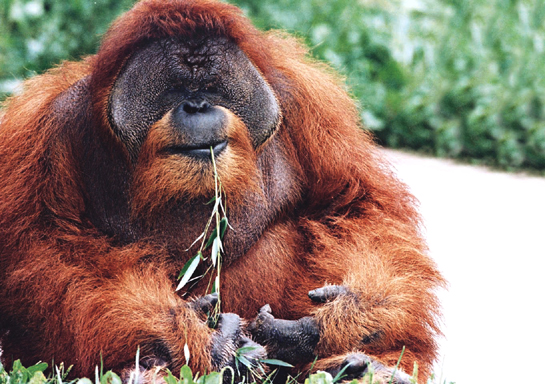
Fu as a 250-pound (114 kg) pasha. A pasha is a full-grown male with cheek pads.
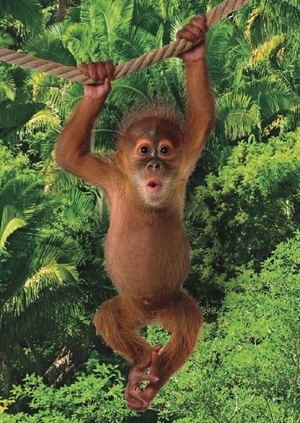
In the wild, baby orangutans like this one stay with their moms eight years or more.
Chapter 1
A SCAMP IS BORN
July 1965, Omaha, Nebraska
A young orangutan peers out of his cage at the Henry Doorly Zoo. No humans are in sight. The coast is clear.
He sticks his long fingers through the chain-link fence. He bends back one corner. He pulls. ZZIIIIP! The stiff metal fencing unravels like a hand-knit scarf.
Some time later, veterinarian Lee Simmons arrives at work. He rounds a bend in the path and yikes! Dr. Simmons stops in his tracks. It couldnt be, but it is. A shaggy, red-haired ape sits up in a tree. How did he get loose?
The ape is about six years old, tailless, and weighs 100 pounds (45 kg). He has a mustache and beard like a famous movie character. For that reason he is called Fu Manchu. Fus arms are super strong and longer than most fourth graders are tall. In a wrestling match against a man, the orangutan would win.
The ape doesnt move or make a sound. But Dr. Simmons sees a twinkle in his eyes. The vet cant help but wonder if Fu knew what he was doing. Its likehes been sitting there just waiting for me.
Fu climbs down. The sun sparkles on his red hair as he scrambles back to his cage. Dr. Simmons follows, shaking his head. What a crazy ape! He locks Fu inside. He calls someone to fix the fence and then goes about his normal business. And Fu goes about hisdreaming up more hijinks to come.
Fu was born in a rain forest on the Indonesian island of Sumatra (sounds like SUE-MAH-TRA ). Like most baby orangutans, Fu probably never knew his father. Orangutan mothers care for their helpless babies. Fus mother nursed him. She held him and snuggled him. Every night she built them a nest high in the treetops.
These sleeping nests were the size of bathtubs. Fus mother made them by twisting leafy branches together. Each fresh, new nest must have felt as comfy to Fu as clean bedsheets do to you.
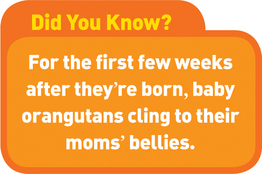
Usually Fu and his mom stayed dry in their cozy bed in the sky. At other times thunder boomed. Rain fell in sheets. Then the apes huddled together and turned giant leaves into umbrellas.
During the day, Fu often rode on his mothers back. He clutched her hair as they swung through the trees looking for durian (sounds like DUR-EE-ANN ) fruits. Durian fruits stink like sweaty gym socks. But orangutans go ape for the smelly stuff.
The problem is durian fruits dont all ripen at the same time, and the trees are scattered. To find them, orangutans must keep a map of the forest inside their heads. For Fus mother it must have been like memorizing a school bus route with hundreds of stops.








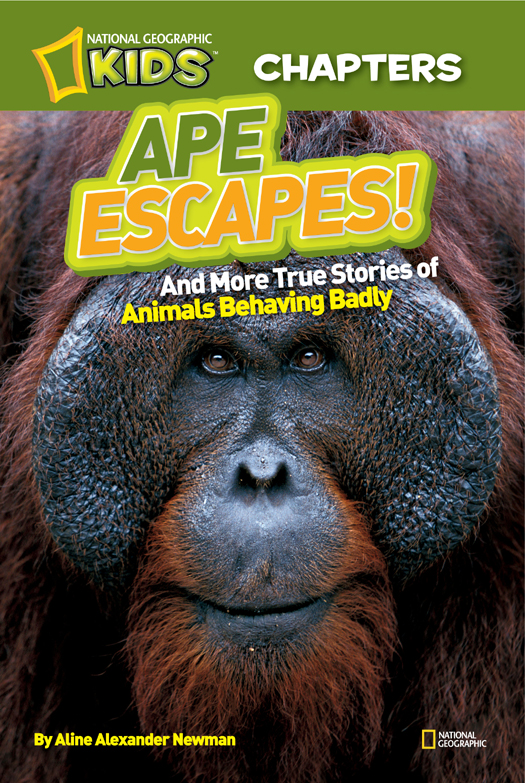
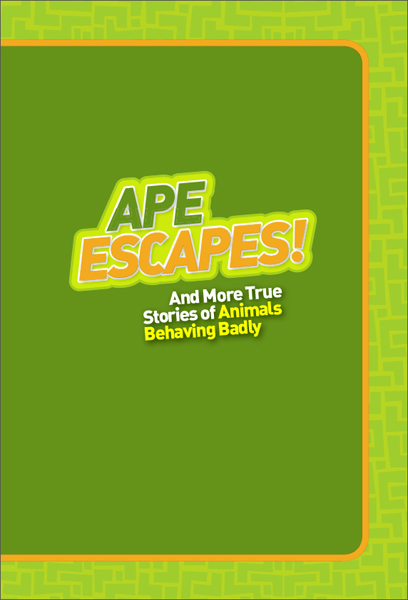
 The National Geographic Society is one of the worlds largest nonprofit scientific and educational organizations. Founded in 1888 to increase and diffuse geographic knowledge, the Society works to inspire people to care about the planet. National Geographic reflects the world through its magazines, television programs, films, music and radio, books, DVDs, maps, exhibitions, live events, school publishing programs, interactive media and merchandise. National Geographic magazine, the Societys official journal, published in English and 33 local-language editions, is read by more than 38 million people each month. The National Geographic Channel reaches 320 million households in 34 languages in 166 countries. National Geographic Digital Media receives more than 15 million visitors a month. National Geographic has funded more than 9,400 scientific research, conservation, and exploration projects and supports an education program promoting geography literacy. For more information, visit nationalgeographic.com.
The National Geographic Society is one of the worlds largest nonprofit scientific and educational organizations. Founded in 1888 to increase and diffuse geographic knowledge, the Society works to inspire people to care about the planet. National Geographic reflects the world through its magazines, television programs, films, music and radio, books, DVDs, maps, exhibitions, live events, school publishing programs, interactive media and merchandise. National Geographic magazine, the Societys official journal, published in English and 33 local-language editions, is read by more than 38 million people each month. The National Geographic Channel reaches 320 million households in 34 languages in 166 countries. National Geographic Digital Media receives more than 15 million visitors a month. National Geographic has funded more than 9,400 scientific research, conservation, and exploration projects and supports an education program promoting geography literacy. For more information, visit nationalgeographic.com.

